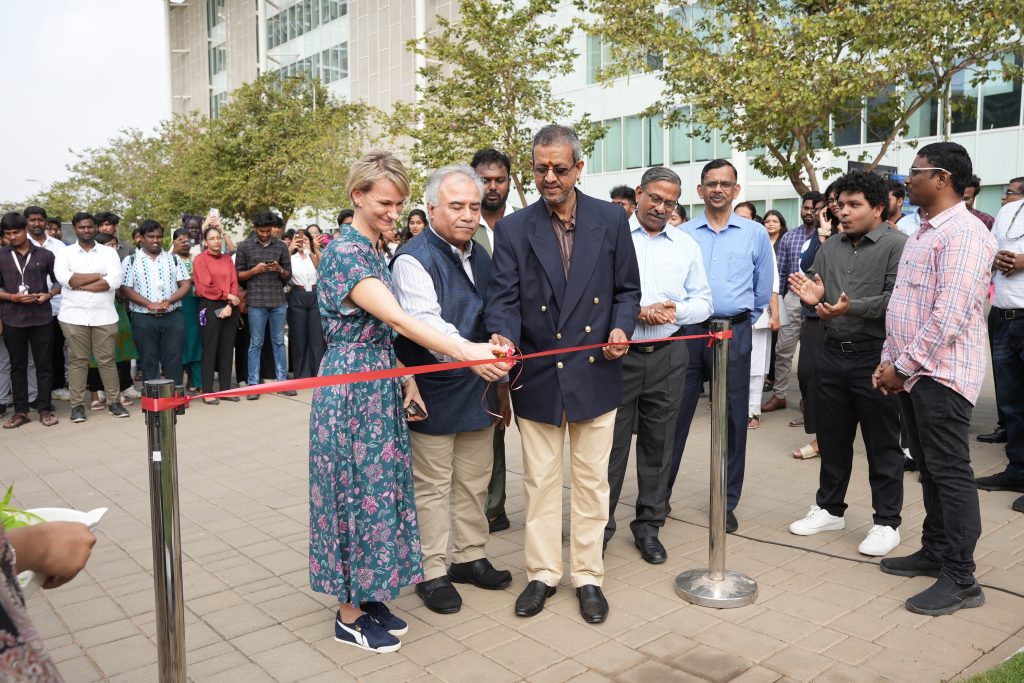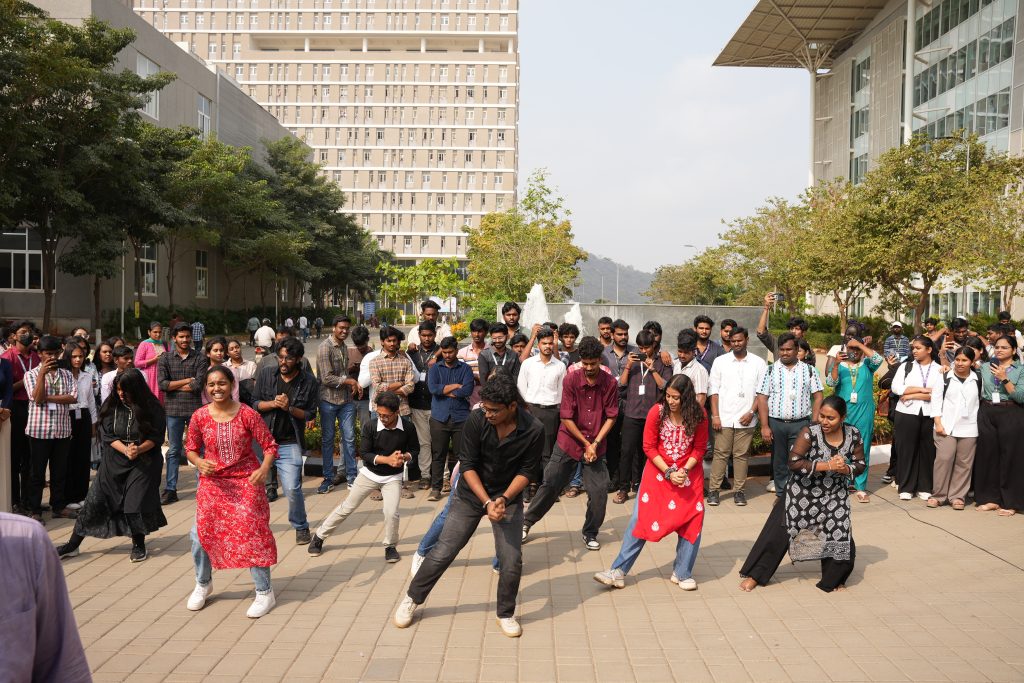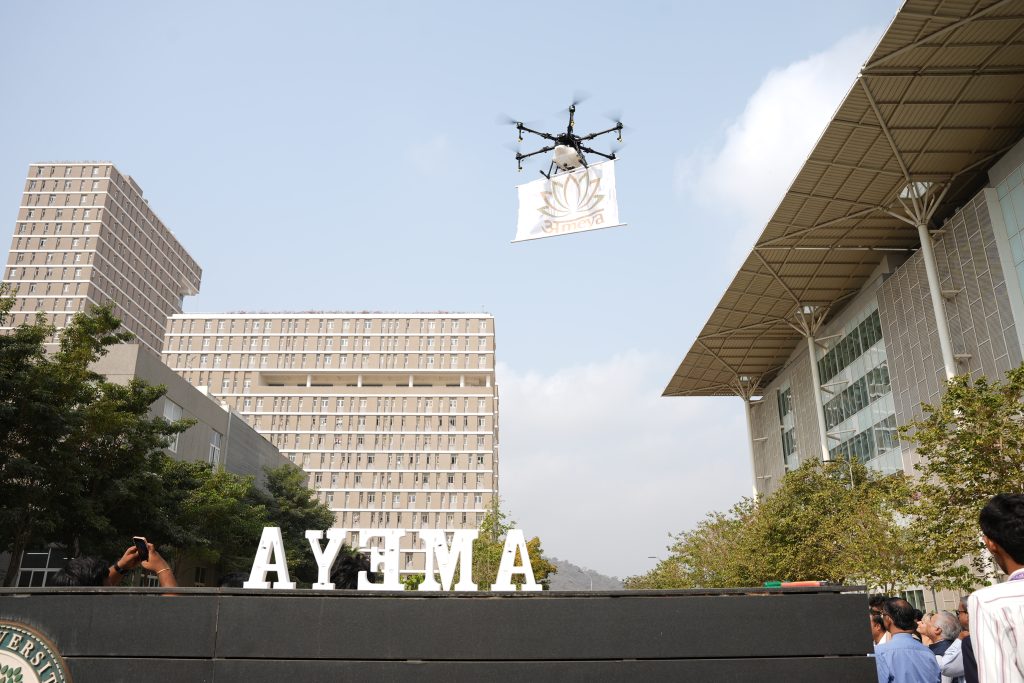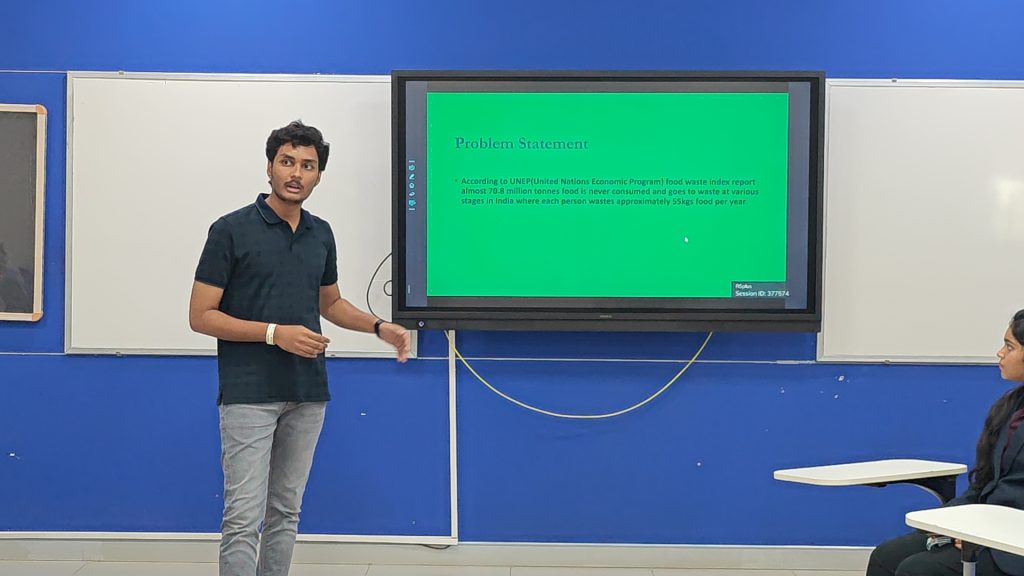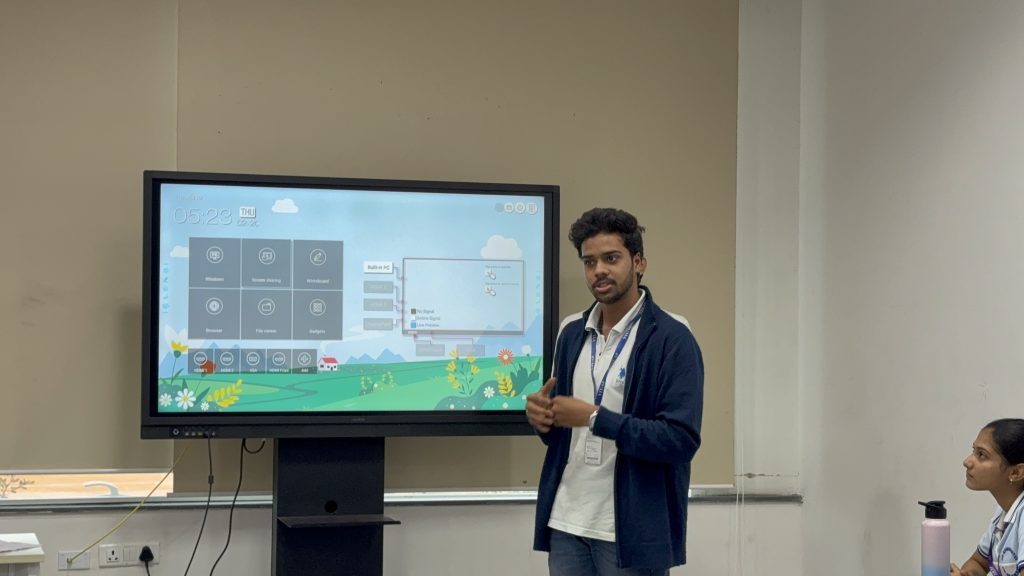Dr Haque’s Patent Revolutionises the Digital Marketing Landscape
 The patent titled “System and Method for Controlling the Dissemination of Data on Digital Platforms,” authored by Assistant Professor, Dr M Asadul Haque from the Department of Management and his research Scholar Mr Suman Kumar Tiwari offers an innovative approach to enhancing advertising strategies on digital platforms. With application number 202541004114, their patent outlines a comprehensive system that utilises real-time data collection and analysis to optimise consumer engagement and improve brand effectiveness in the ever-evolving landscape of social media advertising.
The patent titled “System and Method for Controlling the Dissemination of Data on Digital Platforms,” authored by Assistant Professor, Dr M Asadul Haque from the Department of Management and his research Scholar Mr Suman Kumar Tiwari offers an innovative approach to enhancing advertising strategies on digital platforms. With application number 202541004114, their patent outlines a comprehensive system that utilises real-time data collection and analysis to optimise consumer engagement and improve brand effectiveness in the ever-evolving landscape of social media advertising.
Abstract
The patent outlines a novel system and method for optimizing the dissemination of data on digital platforms, specifically targeting the enhancement of advertising strategies through real time data collection and analysis. This system leverages APIs and web scraping for continuous, up-to-date consumer behaviour monitoring, enabling brands to make immediate adjustments to their advertising tactics based on current trends and insights. It employs advanced machine learning algorithms and sentiment analysis to detect intricate consumer response patterns, offering a nuanced understanding of advertisement effectiveness. Additionally, the system supports dynamic strategy optimization, facilitating real-time adjustments to advertising efforts in response to market and consumer behaviour shifts. It incorporates a holistic evaluation approach, considering various mediating and moderating factors such as consumer attitudes and platform types. Designed for scalability across multiple social media platforms, the system ensures compliance with data privacy regulations while performing real-time data collection and analysis. Ultimately, this patent presents a comprehensive feedback system aimed at improving consumer engagement and conversion rates through personalized and effective advertising strategies.
Explanation in Layperson’s terms
The research presents an innovative system aimed at improving advertising strategies on social media platforms. This smart system uses data analysis and machine learning to help brands understand the impact of their ads on consumer buying decisions. By collecting and analysing data from social media, it considers various factors such as ad content, social trends, and consumer sentiments. The system can predict the effectiveness of different advertising strategies before they are implemented, enabling brands to make informed decisions.
Traditional methods focus on basic metrics like ad clicks, but this invention provides a comprehensive view of what influences consumer behavior. It allows brands to adjust their advertising strategies in real-time based on consumer reactions, making campaigns more effective.
Benefits for businesses include better consumer engagement, higher sales, data-driven decision-making, and more efficient use of advertising budgets. The technology is particularly valuable for marketing agencies, online retailers, consumer product companies, and tech startups focused on marketing solutions.
Practical Implementation
The practical implementation of the new advertising system involves several key steps to ensure its effectiveness and ethical use. Firstly, the system integrates with existing social media platforms and advertising tools like Facebook Ads and Google Ads, enhancing advertising strategies. To ensure successful adoption, companies need to provide comprehensive training and support for their marketing teams, enabling them to use the new tools and interpret insights effectively. Before a full-scale rollout, businesses can conduct pilot programs to test the system on a smaller scale and make necessary adjustments based on real-world results. Ensuring adherence to data privacy regulations, such as GDPR, is crucial for the responsible and ethical handling of consumer data. Additionally, the system can be customized to meet the specific needs of various industries, by analysing sector-specific consumer behaviour and trends, which ensures tailored and effective advertising strategies.
Social Implications
The social implications of implementing the new advertising system are multifaceted. Firstly, it enhances consumer awareness by enabling brands to create more relevant and personalized advertisements, thus improving consumer experience and engagement. However, there is a potential risk of market saturation, where the overuse of similar strategies by multiple brands could overwhelm consumers with excessive ads. Privacy concerns are also significant, as increased data collection necessitates a careful balance between effective targeting and respecting consumer privacy. Additionally, automation and advanced analytics may shift job roles within marketing teams, prompting the need for reskilling towards more strategic, creative, and analytical tasks. The system promotes ethical marketing practices by leveraging data-driven insights to prevent misleading advertisements and ensure truthful marketing messages. Lastly, by understanding consumer sentiment, brands can influence societal trends and public perceptions, particularly through socially responsible marketing efforts.
Future Research Plans
• Exploration of Data Privacy Solutions- Investigate methods to enhance data privacy and security while still leveraging consumer data for effective advertising.
• Longitudinal Studies on Consumer Behaviour- Conduct longitudinal studies to understand how consumer behaviour changes over time in response to targeted advertising.
- Published in Departmental News, News, Paari Current Happenings, Research News
National Symposium on Rethinking Gandhi in Contemporary Times
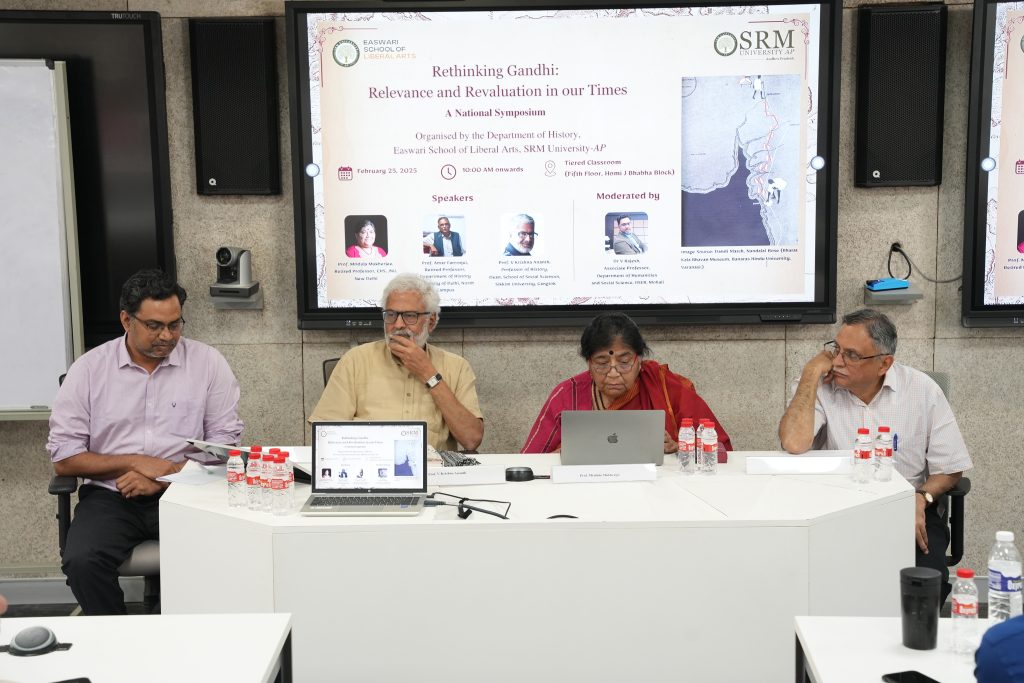
The Department of History from the Easwari School of Liberal Arts, hosted a national symposium on “Rethinking Gandhi: Relevance and Revaluation in our Times,” focusing on the facets of Gandhian legacy of meditation and tolerance. The symposium, held on February 25, 2025, witnessed an assembly of noted stalwarts of Gandhian Studies and modern South Asian history whose expertise in unpacking Gandhi and his politics is noteworthy. Prof. Mridula Mukherjee, Retired professor, JNU, Prof. Amar Farooqui, Retired professor, University of Delhi-North Campus, Prof. V Krishna Ananth, Professor of History, Dean of the School of Social Sciences, Sikkim University, Gangtok, delivered insightful sessions at the symposium moderated by Dr V Rajesh, Associate Professor, Department of Humanities and Social Science, IISER, Mohali.
Prof. Vishnupad, Dean of Easwari School of Liberal Arts, gave a comprehensive account of the relevance of revisiting the Gandhian legacy and ideology of inclusivity, compromise and tolerance in the contemporary world. He also opined the importance of liberal arts education in redefining oneself and shaping young minds into leaders and change-makers of tomorrow.
The symposium highlighted three perceptive lectures by leading academicians in Gandhian Studies. Prof. Mridula Mukherjee elucidated Gandhi as a leader of civil liberties. She commented, “Gandi’s doctrine placed democracy, civil liberties, and the notion of dissent in the forefront. His political ideology played with the terrains of legality and legitimacy.” Prof. Amar Farooqui discussed Gandhi’s relevance, particularly in relation to the idea of secularism. He commented, “Gandhi is uncompromisingly secular” and emphasised that Gandhi’s understanding of secularism remains relevant today.
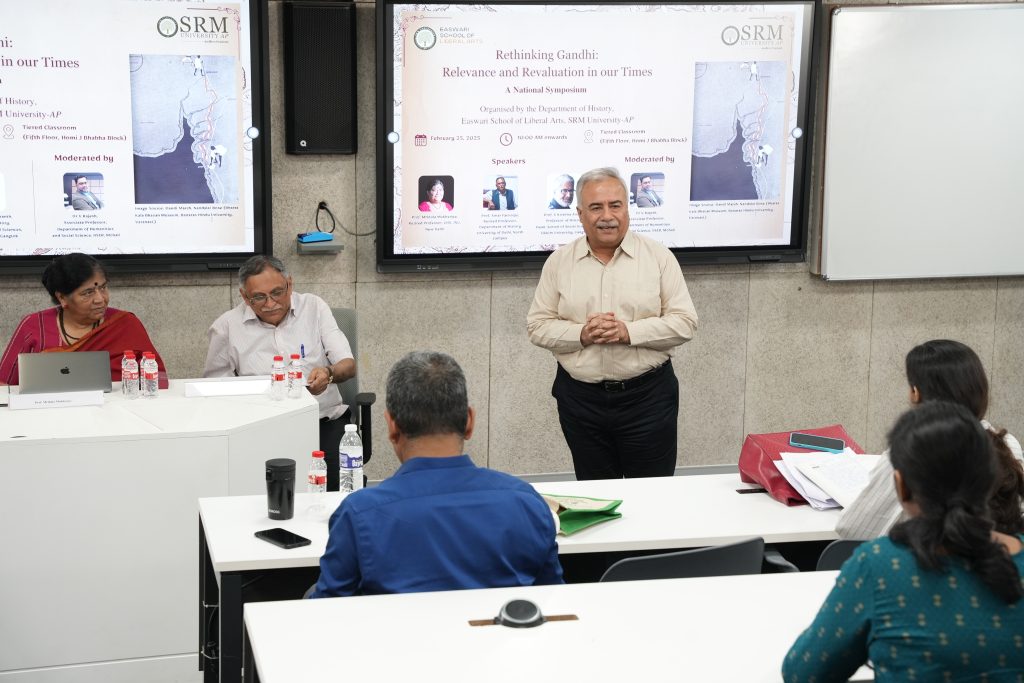
Prof. V Krishna Ananth highlighted that tolerance was central to Gandhi’s journey. He remarked that Gaandhi’s activism exposed the exploitative nexus between colonialism and financial power, a reality that remains relevant today. Dr V Rajesh moderated a Q&A session following the lectures.
Vice Chancellor Prof. Manoj K Arora expressed his appreciation to the Department of History and the Easwari School of Liberal Arts for this formidable initiative. He stated, “The National symposium is hugely beneficial for liberal arts students to enlighten the idea of swaraj. It is important for young minds to imbibe Gandhi’s teachings to strive towards a right and judicious world”.
The symposium aimed at revisiting Gandhi’s legacy, ideology, and vision and their relevance in the contemporary world. The event featured the participation of the Associate Dean of Easwari School of Liberal Arts, Prof. Vandana Swami, Head-Department of History Dr Aqsa Agha, Convenor of the symposium, Dr Maanvender Singh, faculty from the Liberal Arts school, research scholars, and students.
- Published in Departmental News, History Current Happenings, News, Research News
Collaboration with Sibar to Boost Research Advancements
 SRM University-AP formalised a significant Memorandum of Understanding (MoU) with the Sibar Institute of Dental Sciences, Guntur. The MoU is aimed at advancing the field of Biomedical Engineering & Biomedical Sciences and leverage SRM University-AP’s technical expertise alongside the medical proficiency of Sibar Institute, to foster groundbreaking innovations.
SRM University-AP formalised a significant Memorandum of Understanding (MoU) with the Sibar Institute of Dental Sciences, Guntur. The MoU is aimed at advancing the field of Biomedical Engineering & Biomedical Sciences and leverage SRM University-AP’s technical expertise alongside the medical proficiency of Sibar Institute, to foster groundbreaking innovations.
The MoU was signed in a ceremony by Principal, Dr B Venkat Ramana Reddy from Sibar Institute of Dental Sciences and Registrar, Dr R Premkumar from SRM University-AP. Notable attendees included Vice Chancellor, Prof. Manoj K Arora, Dean-SEAS Prof. C V Tomy; Dean-Research Prof. Ranjit Thapa; Head of the Department of ECE, Dr K A Sunitha; Chief Medical Officer, Dr Raju Dudam from the SRM AP Medical Centre, alongside faculty from the Departments of Computer Science and Engineering, Electronics and Communication Engineering, Biological Sciences and Chemistry and medical practitioners from Sibar Institute of Dental Sciences including Dean, Dr L Krishna Prasad; Dr K Kiran Kumar, Prof and Head, Department of Oral Pathology; Dr P Chandrashekhar, Professor- Department of Pathology and Dr D Ravinath Professor & Head, Department of Peridontics.
During the event, Vice Chancellor Prof. Manoj K. Arora pointed out the university’s rapid growth in both research and academic realms. He highlighted SRM AP‘s collaborations with esteemed institutions abroad stressing on the varsity’s commitment to interdisciplinary learning and research. Prof. Arora stated, “By merging engineering brilliance with medical sciences, we aim to achieve breakthroughs that will significantly benefit the society.”
Registrar Dr R Premkumar articulated the university’s dedication to research and its mission to bring transformational change. He remarked, “Our Faculty is our greatest asset, and we are prepared to extend all support to foster a transformative change in the society.”
Discussions from Dean-Research Prof. Ranjit Thapa, Dean-SEAS Prof. C V Tomy, and Associate Dean ( Admission Outreach and Research Collaborations), Prof. Jayaseelan Murugaiyan, on the collaborative research opportunities and clinical studies between the two institutions added significant value to the partnership.
Dean, Dr L Krishna Prasad from Sibar Institute of Dental Sciences expressed his enthusiasm in partnering with SRM AP and looked forward to this collaborative engagement to make significant breakthrough in the field of medical sciences and research.
Dr K A Sunitha highlighted the potential for knowledge exchange through this partnership, noting plans for joint data collection and analysis. The collaboration will extend to community welfare too, wherein dental health camps in the six villages adopted by SRM AP will be offered.
- Published in Departmental News, ECE NEWS, News
Ameya’25: The Management Mavericks’ Meet
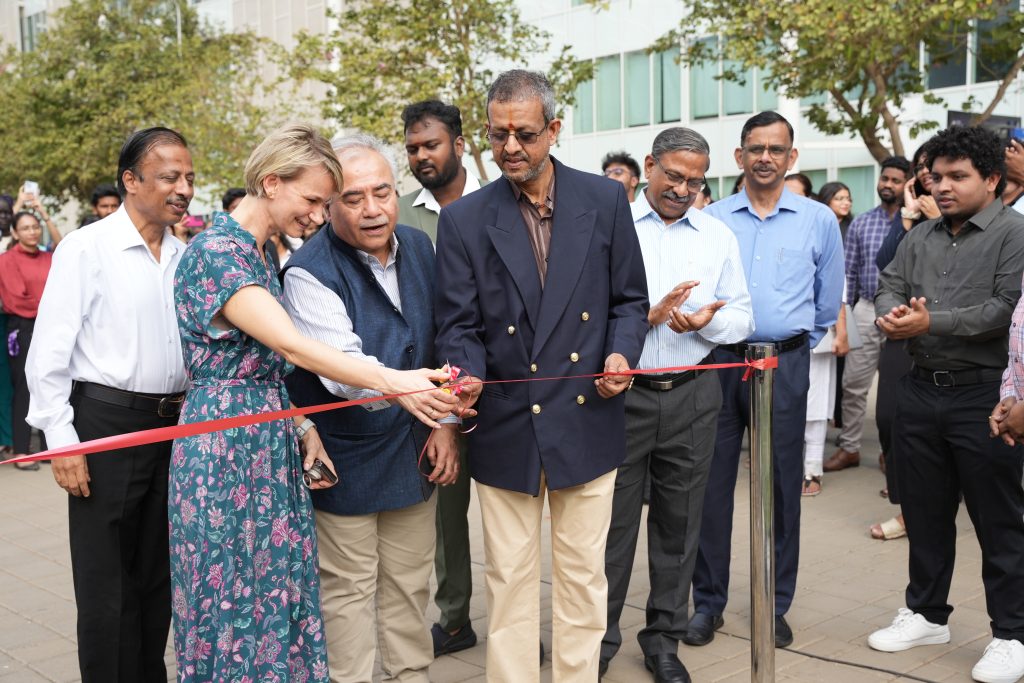 AMEYA 2025, the annual flagship event of SRM University-AP’s management precinct, concluded with great success. The two-day event brought together a vibrant mix of entrepreneurial spirit, formal business interactions, and engaging cultural activities, creating an amalgamation of spirit, strategy and synergy. With Business Standard as its media partner and Board Infinity, IDP International Education Specialist, Unstop, Simple, and Dream Abroad as its other collaborative partners, AMEYA 2025 provided a platform for innovative ideas and networking opportunities.
AMEYA 2025, the annual flagship event of SRM University-AP’s management precinct, concluded with great success. The two-day event brought together a vibrant mix of entrepreneurial spirit, formal business interactions, and engaging cultural activities, creating an amalgamation of spirit, strategy and synergy. With Business Standard as its media partner and Board Infinity, IDP International Education Specialist, Unstop, Simple, and Dream Abroad as its other collaborative partners, AMEYA 2025 provided a platform for innovative ideas and networking opportunities.
The B-Fest was officially launched by Vice-Chancellor Prof. Manoj K Arora, Registrar Prof. R Prem Kumar, and Dean-Paari School of Business, Prof. Bharadhwaj Sivakumaran The highlight of the inauguration was the unveiling of the AMEYA flag through a drone, symbolising the limitless potential the fest aimed to unlock. The event also attracted more than 600 external participants from various educational institutions such as VIT University, Amrita Vishwa Vidyapeetham, Andhra Loyola College, Nalanda Degree College, Loyola Public School, Vignan, KL University and Siddhartha College among many others.
Some of the highlights of AMEYA ’25 were Business Quiz – The Auctor Inquirer, which challenged participants’ knowledge of business concepts and current affairs. The highlight of the formal events was Magistrus – The Skill Manager, a Best Manager event that assessed participants’ leadership, decision-making, and multitasking abilities. Among the many informal events were the IPL Auction, Reel, Open Mic / Stand-Up Comedy, Biz Hunt, the Mr & Ms Ameya competition and lastly the awe-inspiring Chenda Melam.
With 28 winners emerging victorious across a range of competitions, the event showcased exceptional talent. Mr Dishi Jain and Ms Octavio \were crowned Mr & Ms AMEYA’25; Mr Vignesh and his team triumphed in the Biz Hunt alongside Shashank and his team as the runner ups. Shaleem Raju, John Hamsa and Kannam Naidu won the B-Quiz. The fest proved that success knows no bounds when passion and talent unite. AMEYA’25 truly lived up to its name: boundless in spirit, competition, and celebration.
- Published in Departmental News, News, Paari Current Happenings

















